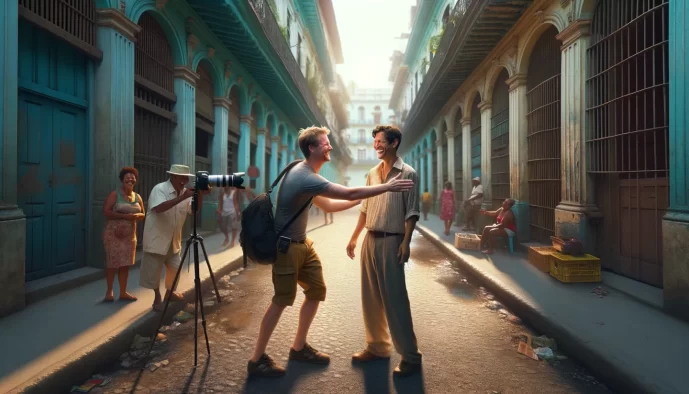How to take pictures of people when you travel : tips for engaging, asking permission
Elevate your photography game with expert tips on composition and etiquette.

Introduction to Snap & Respect
Photography is a powerful form of expression, a blend of art and technology that captures moments, tells stories, and preserves memories. To excel in this craft requires a blend of technical skills, creative vision, and a deep respect for the subject.
Understanding Composition
Composition is the arrangement of visual elements within a frame. It’s a fundamental aspect of photography that can transform a snapshot into a compelling image.
Rule of Thirds
Imagine your image is divided into nine equal segments by two vertical and two horizontal lines. The Rule of Thirds implies that you should position the most important elements in your scene along these lines, or at the points where they intersect.
Leading Lines
Use natural contours or constructs within the scene to guide the viewer’s eye towards the focal point. Leading lines create a path for the eye to follow, adding depth and perspective.
Framing Your Subject
Encapsulate your subject within a natural frame to isolate the main point of interest. Framing adds context and focuses the viewer’s attention.
Mastering Lighting
Lighting can dramatically alter the mood and success of your photo. Understanding and manipulating light is crucial.
Natural Light vs. Artificial Light
Natural light provides a soft and warm quality, while artificial light offers more control. Embrace the strengths of each to create the desired effect.
The Golden Hour
The hour after sunrise and before sunset, known as the Golden Hour, offers a magical quality of light that is softer and warmer, perfect for portraits and landscapes.
Shadow Play
Shadows can add drama, shape, and depth to a photograph. Embrace shadow play to add an element of mystery or highlight textures.
Getting the Right Focus
Sharp focus is essential in most photographic situations. It draws the viewer’s eye to the main subject.
Autofocus vs. Manual Focus
Autofocus is convenient and quick, whereas manual focus allows for precision, especially in challenging light or with macro subjects.
Depth of Field
Depth of Field (DoF) determines the extent to which the background and foreground are in focus. Control DoF through aperture settings to emphasize your subject or capture detail throughout the scene.
Respecting Your Subjects
Photography is not just about capturing images; it’s about doing so with ethics and integrity.
Consent and Privacy
Always seek consent when photographing individuals, and be mindful of privacy. It’s not just ethical; it’s respectful.
Cultural Sensitivity
Be aware of and sensitive to cultural norms and practices. Cultural sensitivity is paramount when photographing events, ceremonies, or in different countries.
The Ethics of Editing
Post-processing is an extension of the photographic process, but it comes with its own set of ethical considerations.
Keeping It Real
A touch of editing can enhance an image, but keep alterations to a point where the photo remains a truthful representation. Keeping it real maintains the integrity of your work.
When It’s Too Much
Over-editing can lead to images that are artificial and deceptive. Recognize when it’s too much and keep the essence of the original scene.
Gear and Accessories
The right tools can enhance your ability to capture great photographs.
Must-Have Equipment
A reliable camera, a versatile lens, and a sturdy tripod are must-have equipment for any photographer. These form the foundation of your gear.
Enhancing Your Kit
Consider additional lenses, filters, and a flash to enhance your kit. Each addition serves a purpose, enabling you to tackle a wider range of photographic scenarios.
Conclusion: Practice and Patience
Photography is a journey of continual learning. Hone your craft with practice and patience, always striving to improve your vision and technique while respecting your subjects and their stories. Remember, the best camera is the one you have with you, and the best photograph is the one that respects the moment it captures.